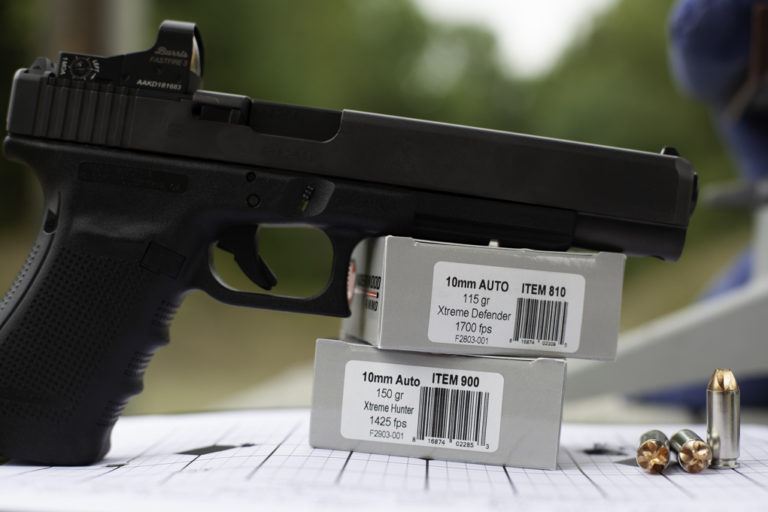
What 10mm ammo has you covered for self-defense and hunting?
Self-Defense:
Hunting:
- Federal 180-grain Trophy Bonded JSP
- Buffalo Bore Heavy Outdoorsman 220 grain
- Underwood Ammo 150-grain Xtreme Hunter
Training:
Languishing in semi-obscurity for a good quarter century, the 10mm has earned new-won respect in recent years. There’s plenty of reasons for Col. Jeff Cooper's darling wandering the wilderness all those years. The first pistol chambered for the powerful cartridge – the notorious Bren Ten – didn’t exactly pirouette onto the stage. And similar to the .44 Magnum, average shooters liked the concept of the snappy cartridge on paper better than when the squeezed the trigger.
As to its rise, who’s to say exactly? From my perspective, the safe wager is that it’s the 10mm’s versatility that has captured ever-fickle shooters’ imaginations. It shoots longer, hits harder and has potentially more applications than any other semi-automatic pistol cartridge today. If you’re willing to spend the time to master the 10mm’s stout, yet manageable recoil you have an unparalleled self-defense cartridge and top-notch medium- to large-game option. Heck, once you get to know it, the big ten is also plenty of fun at the range.
Choosing 10mm Ammo
Multi-talented, the 10mm is generally preferred for two primary purposes: self-defense and hunting. There is a crossover between 10mm ammo and these applications. But outside revolvers, perhaps no other caliber has more specialized rounds for these purposes.
This means that not every self-defense round cuts muster on the hunt and not every hunting round is appropriate for personal protection. With that in mind, we've created a 10mm ammo list broken down to these purposes (plus a range fodder suggestion) and we set slightly different criteria in their selection. For self-defense ammo the benchmarks we considered were: met FBI penetration protocol, substantial bullet expansion, manageable recoil for bullet weight and reliable feeding. On the other hand, hunting ammunition was measured on maximum penetration, bullet robustness and potential maximum range. Not that you want to push a handgun shot in the field, but it’s peace of mind if the first shot fails to do the job and you need to follow up.
Get An Edge On The 10mm:
- The 10mm Auto: Cooper’s Big Bore
- A Perfect 10: The Best 10mm Handgun
- Glock 10mm: The Caliber's Stalwart Option
How We Made Our Picks
Delivering you the top pick in 10mm ammo was a team effort, involving not only myself, but other Gun Digest staff and some of our most trusted long-running freelancers. Our backgrounds include everything from master gunsmith to law enforcement and one absolute, dye-in-the-wool 10mm hunting fanatic. These ammo options were tested through multiple handguns by multiple shooters for accuracy and terminal performance. Other options were tested, but these were the ones that came to the top.
Defensive Ammunition
Hornady 175-grain Critical Duty
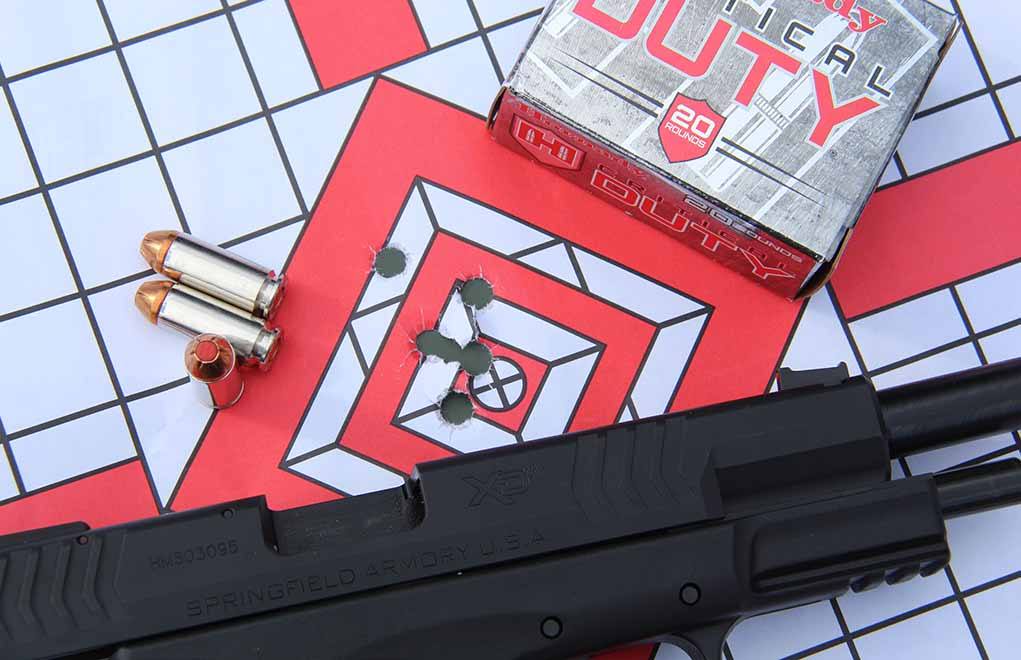
Specs
Bullet: 175 gr. FlexLock
Muzzle Velocity (fps): 1,160
Muzzle Energy (ft-lbs): 523
Ballistic Coefficient: .160
Sectional Density: .156
MSRP: $37.99 box of 20
Pros
- Designed for professional law enforcement use
- Very reliable terminal performance
- Consistent performance in all pistols tested
Cons
- Middling velocity
Why We Picked It
In our testing, we found this a showstopper defensive round.
The 175-grain round is tailored for full-sized handguns and is loaded to provide excellent ballistics and penetration. To the latter, it fully meets not only the FBI’s penetration standards, but also the agency’s barriers tests, giving you a powerful upper hand in almost any self-defense situation.
Over-engineering, a hallmark of Hornady, is to thank for the top-performing 10mm ammo’s performance. Thick jacketed and aided by a Flex Tip core, the FlexLock bullet is designed to expand only when it's supposed to — which isn’t in plywood or heavy clothing.
Furthermore, a jacket-to-core band (Interlock band in Hornady terminology) ensures the bullet holds together and lead core retains mass as it expands. By the company’s statistics, the FlexLock bullet preserves 99-percent of its weight after expansion.
Here's the best part of this ammo, overall we found it extremely manageable out of most handguns we tested it from. Certainly, compact pistols prove jumpier — in our case a Springfield XD-M Elite Compact — but with practice and familiarity controlled followups were achievable.
Speer 200-grain Gold Dot
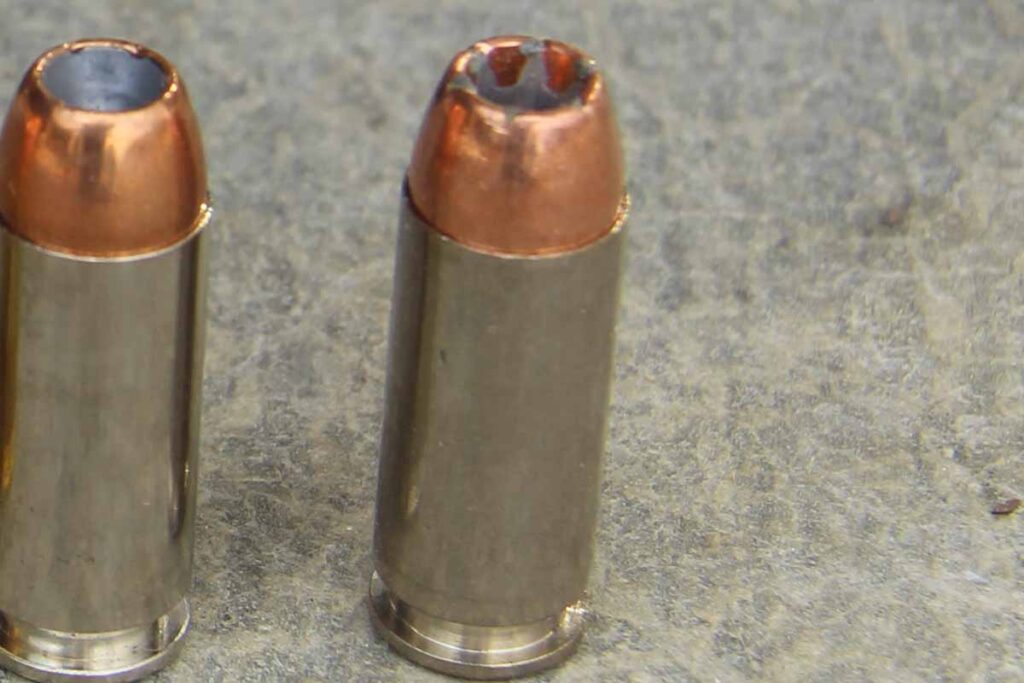
Specs
Bullet: 200-grain Gold Dot HP
Muzzle Velocity (fps): 1,100
Muzzle Energy (ft-lbs): 537
Ballistic Coefficient: .151
Sectional Density: N/A
MSRP: $48.99 box of 20
Pros
- Managable for most shooters
- Devastating terminal performance
- Professional-grad ammunition
Cons
- Tends to be more expensive
In terms of defensive 10mm ammo, 200-grain options are few and far between. Given this, the buzz Speer started at the 2018 SHOT Show with this behemoth addition to the iconic Gold Dot family is understandable.
It’s a lot of jacketed lead to pitch, but it's not just its size that matters.
The round's terminal performance makes it more than worthy of consideration. From our testing on bare ballistics gelatin, the hollow-point expanded nearly a full ¾ of an inch. No matter the situation that should prove more than enough persuasion to halt most attackers dead in their tracks.
Packing plenty of punch, this Gold Dot isn’t loaded to the hilt, thus we found the round very shootable — particularly out of duty-sized pistols (we liked it out of the good ol' Glock 20).
The other area where the ammo acquitted itself well was reliablity across all the pistols we tested it in. Even when the guns were running dirty, we didn't experience a single failure with the ammo.
SIG Sauer 180-grain V-Crown
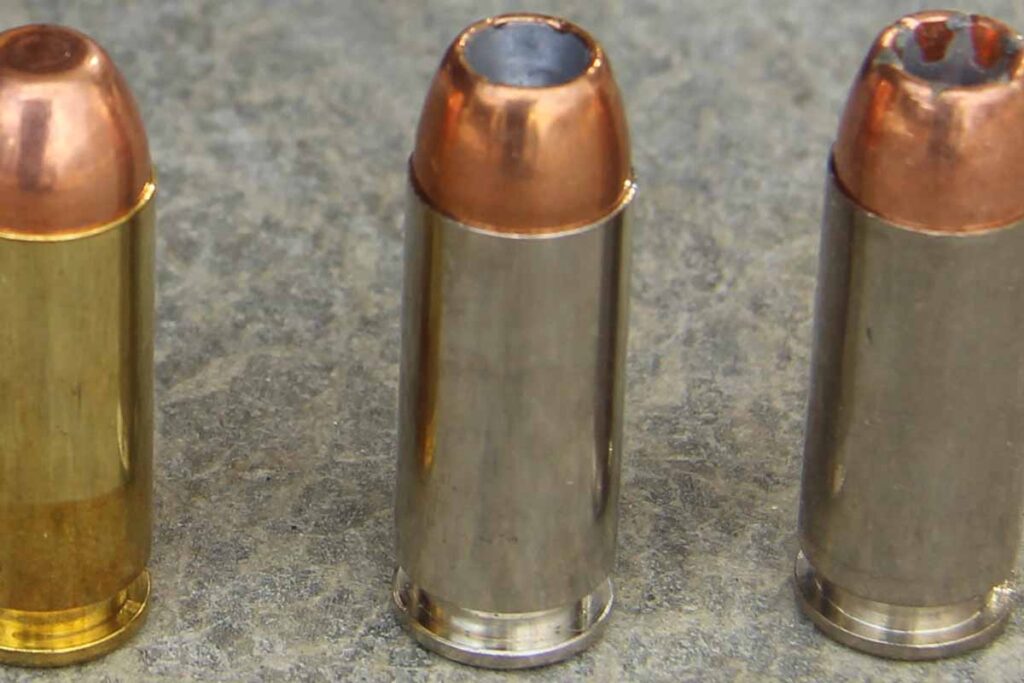
Specs
Bullet: 180-grain V-Crown JHP
Muzzle Velocity (fps): 1,250
Muzzle Energy (ft-lbs): 624
Ballistic Coefficient: N/A
Sectional Density: N/A
MSRP: $24.99 box of 20
Pros
- Affordable option
- Hits hard
- Expands like the dickens
Cons
- Fairly bucky round in most guns we tested it in
Near blister hot and offering incredible expansion, SIG Sauer has produced one of the wickedest defensive 10mm ammo choices out there.
While the round kicking out of the muzzle around 1,250 fps is right around what most 10 mm aficionados like to see, it’s what the V-Crown bullet does when it hits the target that turns heads. That said, we found for our defensive rounds that SIG tended to produce the most recoil no matter the platform.
In ballistic gelitan the V-Crown projectile balloons like it's gone off its diet, expanding right around ¾ of an inch. But from our experience, all V-Crown options produce these results relative to caliber. It's just mean ammo.
Geeking out a bit, the expansion is thanks to SIG going the extra mile. While many ammo makers are content skiving just the jackets of a defense round, SIG takes these through the hollow point’s lead core ensuring consistent and dynamite expansion round in and out.
Nickel-plated cases are a nice addition to the round, not only for their deadly good looks, but also making chamber checks easier.
Hunting Ammo
Federal 180-grain Trophy Bonded JSP
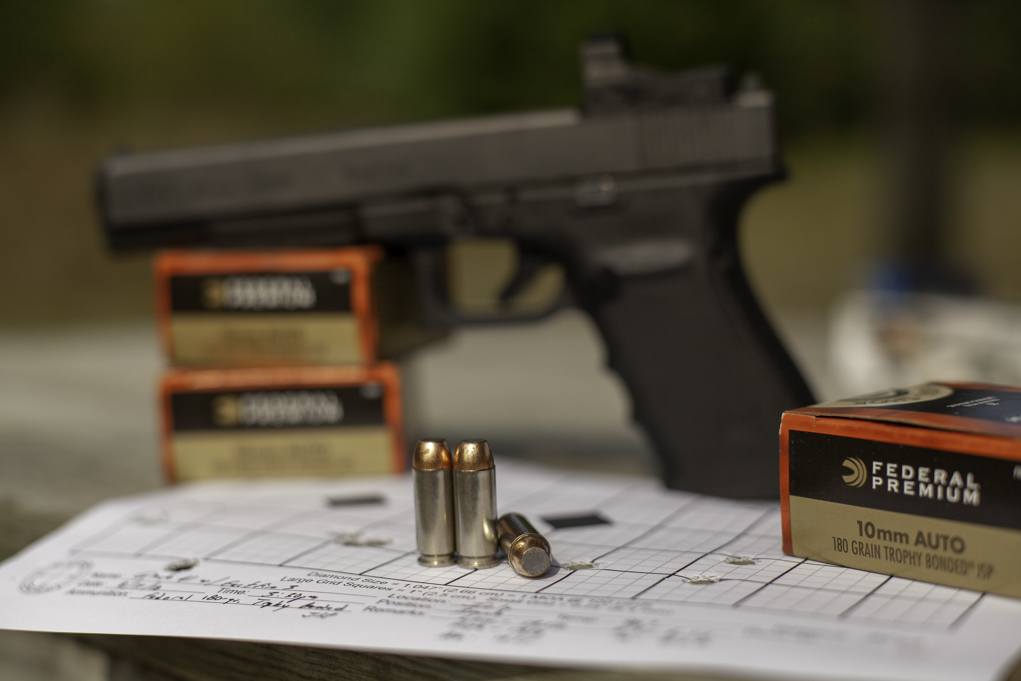
Specs
Bullet: 180-grain Trophy Bonded Bear Claw
Muzzle Velocity (fps): 1,275
Muzzle Energy (ft-lbs): 650
Ballistic Coefficient: 0.134
Sectional Density: N/A
MSRP: $44.99
Pros
- Very flat shooting and accurate
- Manageable relative to other hunting ammo
Cons
- Expensive
Designed to smash through tough hide and bone, Federal’s specialty 10mm hunting ammo is a proven game getter. Topped with a bullet from the renowned Trophy Bonded line, the jacketed soft point won’t go to pieces in medium- and large-sized game — an absolute must in a handgun hunting bullet.
However, in our testing, it's not the terminal performance potential that turned heads, but the light's out accuracy. At 25 from a rest and out of Glock 40 MOS, the ammo printed .44 inches in it's best group and average 1.5 inches at that range.
Furthermore, we found Trophy Bonded 10mm to be very managable as far as huning ammo is concerned. If required, a follow-up shot is more than feasiable.
From our standpoint, the ammunition is right on target as a deer round and other medium game. But it might not be our first choice as backwood protection against more dangerous game.
Buffalo Bore Heavy Outdoorsman 220 grain

Specs
Bullet: 220-grain Hard Cast plain based LFN
Muzzle Velocity (fps): 1,200
Muzzle Energy (ft-lbs): 703
Ballistic Coefficient: .219
Sectional Density: N/A
MSRP: $44 box of 20
Pros
- Maximum penetration for caliber
- Respectable accuracy
Cons
- Expensive
- Plenty of recoil
Near the heaviest bullet the 10mm can digest, Buffalo Bore has cooked up the answer if penetration is the question. Launching a hard-cast flat nosed bullet, the 220-grain round is designed to handle the largest and toughest critters you’d logically take with a 10mm. A good bet for hunting larger Cervidae or as an insurance policy when traversing bear country.
Engineered for minimal expansion, the bullet nonetheless punches a devastating hole in game and makes child’s play of hide and bone. And with 3 feet of potential penetration at hand from what we saw in ballistic gelatin tests, a well-placed shot will destroy all vitals in the bullet’s path.
The trade-off for these excellent terminal ballistics, Buffalo Bore isn't for the faint of heart. Pushing a 220-grain bullet at around 1,200 fps at the muzzle tends to get a handgun hopping and did so in our case.
Underwood Ammo 150-grain Xtreme Hunter
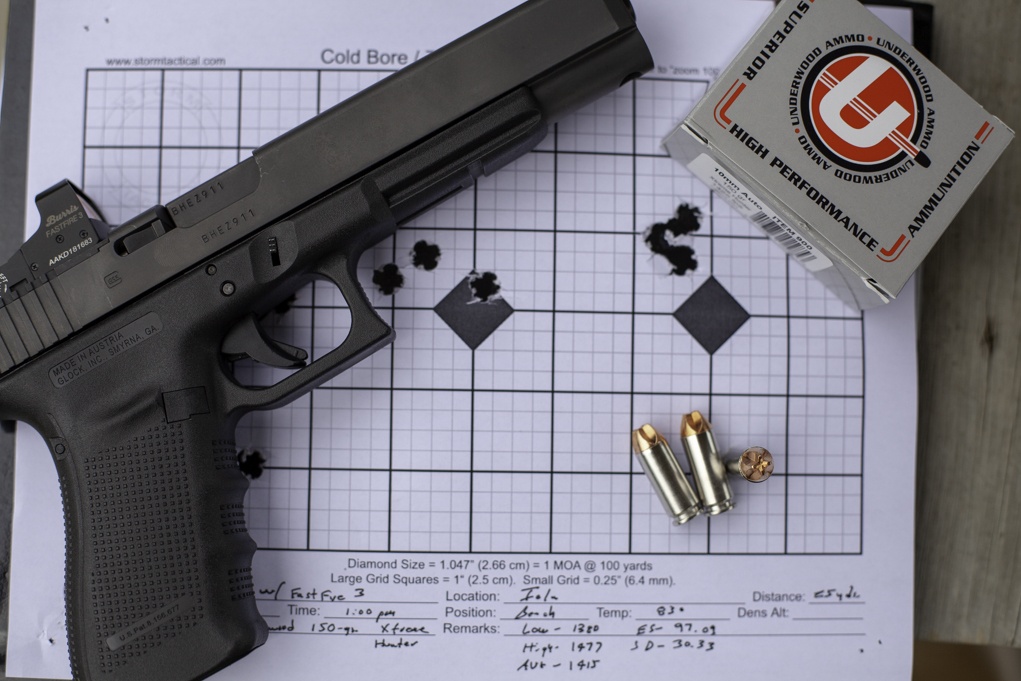
Specs
Bullet: 150-grain Lehigh Defense Xtreme Hunter
Muzzle Velocity: 1,425
Muzzle Energy: 676
Ballistic Coefficient: N/A
Sectional Density: N/A
MSRP: $47.99 box of 20
Pros
- Excellent penetration
- Accurate
- Manageable shooter
Cons
- Most expensive option
Don’t let its lightweight fool you, Underwood’s 10mm hunting round is pure dynamite.
Solid copper, the 150-grain round offers incredible penetration potential. Plain and simple, it won’t break up even against bone and pushes well through most targets.But it perhaps has an advantage over some the hard cast options previously mentioned – wound channel. Milled fluting gives the Xtreme Hunter the unique property of creating a permanent wound cavity greater than many bullets designed to expand.
Even more impressive was Underwood’s 150-grain Xtreme Hunter produced light's out accuracy averaging 1.24 inches at 25 yards and printing a very impressive best group of .53 inches.
Being a lighter round, we also found the option much easier to shoot, despite leaving the barrel at a screaming clip — 1,425 fps. At this velocity, its energy at the muzzle is akin to a projectile 30-grains its weight. At first, it may not look it, but the Xtreme Hunter is more than capable medium to large game 10mm ammo.
Training Ammo
CCI Blazer Brass 200-grain FMJ

Specs
Bullet: 200-grain FMJ
Muzzle Velocity (fps): 1,023
Muzzle Energy (ft-lbs): 465
Ballistic Coefficient: N/A
Sectional Density: N/A
MSRP: $35.99 box of 50
Pros
- Inexpensive
- Accurate
Cons
- Not any nits to pick as training ammo goes
If your only goal is to shoot as much 10mm ammo for the least amount of money possible, CCI Blazer may be the way to go. This stuff is as accurate as the dickens, producing 1.24-inch groups for us at 25 yards, which is pretty dandy for training ammo.
| Ammunition | Bullet | Weight (grains) | Muzzle Velocity (fps) | Muzzel Energy (ft-lbs) | Ballistic Coefficient | Sectional Density | Primary Purpose | Cost (box of 20) | Cost (per round) |
|---|---|---|---|---|---|---|---|---|---|
| Hornady 175-grain Critical Duty | FlexLock | 175 | 1160 | 523 | .160 | .160 | Self Defense | $37.99 | $1.90 |
| Speer 200-grain Gold Dot | Gold Dot HP | 220 | 1100 | 537 | .138 | .178 | Self Defense | $48.99 | $2.24 |
| SIG Sauer 180-grain V-Crown | V-Crown JHP | 180 | 1250 | 624 | N/A | .161 | Self Defense | $24.99 | $1.24 |
| Federal 180-grain Trophy Bonded JSP | Bonded Soft Point | 180 | 1275 | 650 | .134 | N/A | Hunting | $44.99 | $2.25 |
| Buffalo Bore Heavy Outdoorsman 220 grain | Hard Cast plain based LFN | 220 | 1200 | 703 | .219 | N/A | Hunting | $44 | $2.20 |
| Underwood Ammo 150-grain Xtreme Hunter | Lehigh Defense Xtreme Hunter | 150 | 1225 | 676 | N/A | .130 | Hunting | $47.99 | $2.40 |
| CCI Blazer Brass 200-grain FMJ | FMJ | 200 | 1023 | 465 | .173 | .178 | Training | $35.99* | $0.72 |
Load Up On These 10mm Tips
- Factors to Consider: Is 10mm Better Than .45 ACP?
- Maximizing Performance: 10mm Muzzle Energy Explained

Next Step: Get your FREE Printable Target Pack
Enhance your shooting precision with our 62 MOA Targets, perfect for rifles and handguns. Crafted in collaboration with Storm Tactical for accuracy and versatility.
Subscribe to the Gun Digest email newsletter and get your downloadable target pack sent straight to your inbox. Stay updated with the latest firearms info in the industry.

![Best Concealed Carry Guns In 2025 [Field Tested] Wilson Combat EDC X9S 1](https://gundigest.com/wp-content/uploads/Wilson-Combat-EDC-X9S-1-324x160.jpg)


![Best 9mm Carbine: Affordable PCCs [Tested] Ruger Carbine Shooting](https://gundigest.com/wp-content/uploads/Ruger-Carbine-Shooting-100x70.jpg)
![Best AR-15: Top Options Available Today [Field Tested] Harrington and Richardson PSA XM177E2 feature](https://gundigest.com/wp-content/uploads/Harrington-and-Richardson-PSA-XM177E2-feature-100x70.jpg)

Some of the loads are sub par for that round. No better than a 40 S&W. Thing is, did they actually test them? Check out Lucky Gunner Labs I guess.
I agree that some of these loads are sub par for the 10mm. I suspect the article is written (very well) cautiously…
You came close with 10mm self-defense choices, but missed the mark. I’ll explain why. I shoot 10mm and .357Sig…. almost always light Noslers (135gr in 10mm, 115gr in .357 Sig) from Underwood Ammo (or the same weight projectiles in Sierra from Double Tap Ammo). These 10mm’s travel at 1600fps with 767fp of muzzle energy, and the .357 Sig’s travel at 1600fps at 614fp’s muzzel energy.
Why light rounds (your choices are very heavy)? They carry more energy! Shooters tend to lock in on shot placement and wound channel specs in defensive shooting. Most completely ignore the second consideration……hydro-static or hydraulic shock. If you compress the blood vessels in an area enough, the blood has to go somewhere, so the blood ruptures vessels at the weakest points. A hollow-point that hits with over 500fp creates enough hydro-static compression in the vascular system (regardless of the placement) to cause capillaries in the brain (also lungs and aneurysms) to burst.
People shoot poorly under stress. I’ve seen enough well-practiced shooters fail in a simulator to validate this (at least for me). I was pretty bad at first, too. So, the point is, a shooter in a high stress defensive situation may not hit well, so any hit needs to count. If a round carries enough energy into the hit area (say, the lower side torso for example) the vascular system will experience massive compression leading to burst blood vessels in the brain. Even if the attacker is only disoriented and not completely down, you have an immediate advantage.
Light projectiles rarely over-penetrate. That would be a concern of mine with the 180 grain projectiles. Yet, the 135gr Noslers still have good penetration. Wound channel, coupled with adequate hydrostatic shock are my choice for defense. Please let me know if I’VE missed the mark. Cheers.
Dave, i agree with you! I’m of the mantra that speed kills. Plus, I love a really flat shooting round! This has led me to go from 165 gr .30-06 to 150 gr. Even more, my whitetail rifle is now a 6mm creedmoor tossing only 103 grain eld-x bullets, harvesting 2 deer this year, one going 40 yds, the other succumbing to shock instantly never taking a step. I will say, for hunting, I have not gotten the readily apparent blood trails that I normally got with the .30-06, but that is partly due to me switching from low heart shots to upper shoulder brachial plexus shots. All that said, I’m leaning toward the Underwood 155 grain as a deer and defense round in 10mm. In beard country, not sure.
Curious if you’ve tested the 10mm Woodsman by G9. Got an opinion?